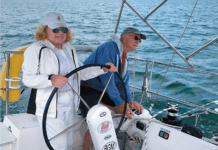Tragically, lives continue to be lost when the use of a harness might have saved them. Many race organizers, including those of the Volvo Ocean Race, require crews to carry harnesses, but they do not dictate when the harnesses should be worn. But this is beginning to change. The venerable Transpac and Newport-to-Bermuda races have taken the lead in requiring both PFDs and harnesses to be worn at night.
It has been seven years (November and December 1999) since Practical Sailor published its last report on safety harnesses and tethers. That test was put together in conjunction with the Seattle-based Sailing Foundation. Since then, increased awareness, and less obtrusive and more comfortable designs have contributed to safety harnesses rising sales. But harnesses, whether carried by professional racers or cruising couples, save lives only if they are worn and clipped on.
Harnesses not only protect the wearer, but they keep safe those would-be rescuers who put themselves in harms way to recover an overboard crew member. So why arent they universally accepted? In changing wind and sea conditions, donning a harness and hooking on can seem more trouble than its worth. Seemingly easy to slip on at the dock, harnesses become frustrating and difficult to don at night in a crowded, dark, and pitching cabin, and they can be easily forgotten in the heat of an emergency.
Photo by Beth Leawood
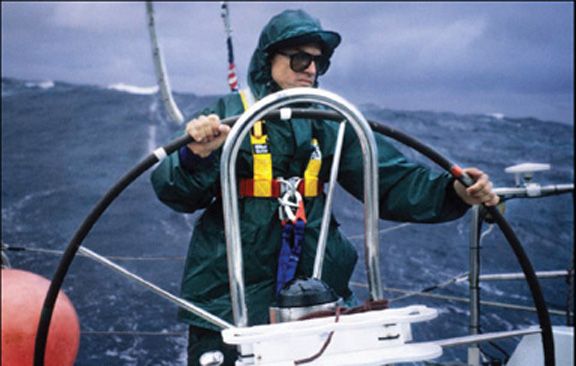
They need to be carefully stowed in a protected but readily accessible location. All harnesses need to be clearly labeled with the size or users name so they are easily identified, and not confused or tangled in a pile at the bottom of a locker.
Inflatable harnesses can be bulky, constricting, and warm. Tethers become cumbersome, frustrating, and sometimes dangerous, especially when the wearer is moving around on deck. Being caught on the wrong side of a jib sheet during a tack, when harnessed and tethered to a boat, can result in injury, and even throw you overboard.
Nevertheless, being tethered to the boat when moving around a rolling deck, or when performing two-handed jobs like steering, exiting a cabin, or trimming and changing sails, is the most reliable method of preventing an overboard tragedy.
PS recommends that before buying any harness, you become familiar with its use. Not all harnesses are alike, and when trusting your life to these pieces of equipment, you want the best fit possible for the job. Harnesses need to be fitted and tested before leaving the dock. Adjustments and allowances for size and clothing should be made.
As body shapes differ, PS recommends that fit be your most important criteria in choosing a harness. Harness packaging marked adult universal sometimes conflicts with owners manual specifications that the minimum height for harness wearers be 5 feet, 5 inches. If these specifications were rigidly applied, half the adult female sailing population would be denied an inflatable PFD harness. In the absence of an alternative, many adult harness users shorter than 5 feet, 5 inches currently do fine wearing an inflatable PFD/harness.
WHAT WE TESTED
PS obtained a cross-section of harnesses for this comparison and divided them into two groups: inflatable PFDs with integrated harnesses and basic harnesses (webbing with no PFD). The combo line-up included harnesses from Mustang, West Marine, and Stearns. Basic harnesses tested were those by West Marine, Plastimo, Sospenders, and Jim-Buoy.
Not all vendors wished their products to be tested, and some quality sailing harnesses were not evaluated, notably the Lirakis and Spinlock. We intend to obtain these products for a follow-up test.
INFLATABLE PFD/HARNESSES
Photos by Sherry McKillop
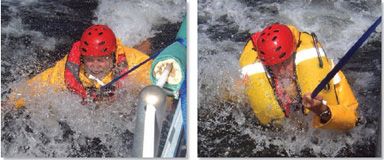
Inflatable PFDs with integrated harnesses have come a long way in comfort, reliability, and simplicity. Their rising popularity is no mystery: Whenever you donned a safety harness, you would also be wearing a PFD. Its quicker to don an inflatable PFD/harness than a separate webbing harness and life jacket. And after years of extensive testing, inflatable PFDs now satisfy Coast Guard PFD Type V requirements for recreational vessels.
Inflatable PFD/harnesses are not without compromises. They are expensive ($150-$375). They are moderately heavy (2-3 pounds), bulky, and need regular maintenance and inspection. Inflatable PFD/harnesses can be more uncomfortable than a harness alone, particularly in tropical climates, where they can chafe the wearers skin.
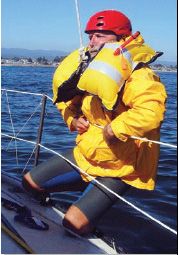
With the waist belt properly tightened, all harnesses tested were secure about the body when towing a crew overboard both alongside and astern. However, no matter what the webbing width, unless multiple layers of clothing or a crotch strap were worn, being lifted vertically by a harness is extremely painful. Crotch straps are optional on some models, and they may keep an MOB from sliding out of a harness, should a vertical lift back on board be necessary.
Some have suggested that a climbers harness with leg straps would be appropriate as a general-use safety harness. The problem is that if you do fall overboard, a climbers harness, being lower on the waist, means the body has a higher center of gravity, and it is likely the MOB would be towed with his head underwater. Nevertheless, climbers harnesses are favored by foredeck crew who must quickly clip on before they ascend rigging.
During PS testing, all auto inflatable PFD/harnesses inflated as testers were dragged alongside. The inflated PFD/harness helped keep the testers head above water while the boat was slowed and stopped. This benefit, however, was offset by the bulkiness of an inflated PFD/harness during recovery. Being pulled aboard either over or through the lifelines is significantly more difficult while wearing an inflated PFD/harness. Familiarize yourself with the PFDs manual deflation system in case you cannot reboard with the PFD inflated.
Of particular note, all inflatable PFD/harnesses PS tested had CO2 cartridges that affected magnetic compasses in varying degrees when in close proximity.
MUSTANG MD 3184

Testers found the automatically inflatable Mustang 3184 PFD with integrated harness easy to don and adjust. Constructed of coated nylon, with a single back strap, a neoprene collar, a low-mounted front buckle and two 1/4-inch stainless D-rings (breaking strength 4,000 pounds) on 1-inch webbing, the MD 3184 was the least constricting around the neck and was the most comfortable of the inflatable PFD/harness PS tested. The one-piece, stainless-steel adjustment slide was simple, positive, and lightweight. The zipper closure around the bladder instead of Velcro tabbed flaps has less tendency to blow open in heavy winds or snag open when brushed against rigging, lifelines, and companionways.
Testers liked that the harness quarter-inch D-rings could be easily tucked under the PFDs lapels and out of the way when not in use, a detail not featured on other brands. With the MD 3184 hydrostatic inflator, no premature inflation or accidental inflation occurred, a previously frustrating habit of older model inflatable PFD/harnesses. The MD 3184 owners manual was easy to read, informative, and well illustrated. The MD 3184 comes in one-size-fits-all, but the owners manual indicates the harness is de-signed to be worn by persons at least 5 feet, 5 inches tall.
Bottom Line: This is a state-of-the-art inflatable PFD with integrated harness. Its expensive, but its thoughtful design makes it worth the money. The MD 3184 is PSs Best Choice.
MUSTANG MD 3084
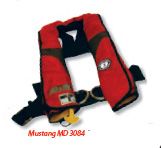
The second Mustang PFD/harness combo we tested was the automatically inflatable Mustang MD 3084. A half-inch wider than that on the 3184, the thicker, 2-inch webbing had no noticeable impact on comfort. The MD 3084 is easy to don and adjust, has double shoulder straps, a neoprene collar, double stainless-steel threading plates for adjustment, and velcro closures on the bladder cover. The D-rings are 5/16-inch stainless steel (breaking strength 6,200 pounds), and can be tucked out of the way when not in use. Heavier than the MD 3184 by 10 ounces, the MD 3084 is otherwise comparable in comfort and function.
Bottom Line: This is a quality product and we recommend it. Its greater weight and use of Velcro bladder closures instead of zippers keep the 3084 from a top ranking.
WEST MARINE 4000

The West Marine 4000 Offshore inflatable PFD with harness, manufactured by Stearns Inc., comes with all the bells and whistles of a top-of-the-line product. The WM 4000 has a Suncor one-piece adjustment slide with an elastic retainer for the excess webbing tail. The nylon webbing is 2 inches wide with a 6,000-pound breaking strength, and is stitched to an abrasion-resistant nylon bladder cover. There also is a flip-up soft collar with an elastic hat retainer. On the PS test harness, the front Delrin buckles and D-rings fit 3 inches higher on the chest than on the Mustang harnesses. Both male and female testers found that this higher location led to more constriction around the wearers neck with no apparent safety advantage. Velcro closures retain the bladder cover and spray flap. The velcro does not do an adequate job of securing the spray flap, which is located behind the neck. When the wearer leans his head back, the velcro separates, and the spray flap begins to open. The spray flap also tends to unsnap from the webbing backstrap, popping upward whenever a moderate strain is applied to the harness D-rings. The inflator is visible behind a clear window, and can be switched from auto to manual inflation with an override tab.
The WM 4000 owners manual was straightforward and complete, and as with the Mustang, the manufacturer does not recommended the 4000 for users shorter than 5 feet, 5 inches. Manufacturers maintain that the harness belt should be 2 inches above the bottom of the wearers rib cage, and the WM 4000 and the Mustang are too large to fit smaller frames correctly.
Bottom Line: This well-constructed PFD/harness is compliant with all ISAF and U.S. Sailing requirements and recommendations. It is not as comfortable as testers would like. The velcro closures and backstrap snap on the spray hood need to be improved, in our opinion.
WEST MARINE 1000
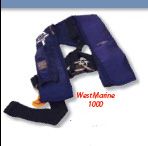
The West Marine 1000 Offshore manual inflatable PFD with harness, also made by Stearns Inc., is similar in most design respects to the heavier 4000. It was the lightest inflatable PFD/harness tested, but it lacks a soft collar, making it less comfortable than the 4000 and leaving the wearer open to neck chafe when it is worn with a collarless shirt or jacket.
Bottom Line: The 1000 would be much improved with a soft collar. Being lightweight, the 1000 is a good choice for inshore racing, where the torso is tucked through lifelines, the head is leaned upward, and quick response time is necessary during tacking and sail handling.
STEARNS 4000
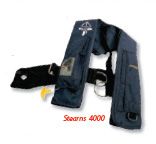
The Stearns 4000 Ultra Offshore inflatable PFD with harness is almost identical to the West Marine 4000, but it has a different automatic inflation system, no comfort collar, and no hat retainer. Otherwise, similar observations apply as to the West Marine-branded product.
Bottom Line: If youre torn between this one and the West Marine 4000, it comes down to whether you want to spend more to get a few bonus features. Both will get the job done.
STEARNS ULTRA
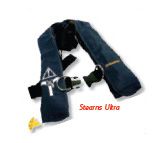
The Stearns Ultra manual inflatable PFD with harness is basic and lightweight. Identical to the West Marine 1000 in design and construction, the Ultra Manual comes in one universal adult size. The lack of neck padding and the poorly secured spray flap are drawbacks, but this utilitarian harness offers a secure option for the bargain shopper.
Bottom Line: The Stearns Ultra is a good choice for those who want an inflatable harness at minimal cost.
BASIC HARNESSES
Basic harnesses are simply webbing with D-rings and adjustment buckles. They are not PFD equipped. Basic harnesses are lighter, more comfortable, and less expensive than inflatable PFD/harnesses. Most meet ISAF specifications for racing. Many sailors, especially professionals, opt for wearing a basic harness and an inflatable PFD in a fanny pack, if required. This method can be less obtrusive during high activity in crowded quarters. Many boats carry both inflatable PFD/harnesses and basic harnesses in their safety lockers.
Basic harnesses can be worn over regular, non-inflatable PFDs, but this set-up is usually awkward and proves less than satisfactory. Basic harnesses can get twisted up while stored, making them frustrating to don at night or in a rush.
WEST MARINE ULTIMATE
Photo by Beth Leawood

0)]
This harness is constructed of soft, 2-inch yellow nylon (shoulder straps) and red nylon (chest belt). It has double quarter-inch D-rings, a front stainless steel buckle, and double, detachable threading plates on the side. In our opinion, the front buckle could make the harness more prone to twisting. It could be eliminated at a further savings in weight and simplicity, as it is on the WM Basic Harness (see below).The WM Ultimate has a whistle and lanyard, an elastic pouch for a personal strobe light or flares, and reflecting tape on the shoulder straps. It also has a back patch designed to keep the shoulder straps separated and to reduce chafing. Testers found the WM Ultimate to be strong, yet very comfortable. It comes in two sizes: medium (32-44 chests) and large (42-54 chests).
Bottom Line: This quality harness gets big points for comfort and features. It is somewhat more difficult to don than the WM Basic harness, but in all other respects, it rates high.
WEST MARINE BASIC
Photo by Beth Leawood

1)]
This basic harness slips on over the head, and is simple, functional, and ultra-lightweight. The 2-inch nylon webbing is supple and strong (breaking strength 5,000 pounds). The tether attachment point is a single quarter-inch D-ring rated at a minimum breaking strength of 2,000 pounds. Like the WM Ultimate, this harness also has a back patch to keep the straps from twisting. The double-plate side adjuster is easy to use and may be disconnected for donning and removal.
Bottom Line: This no-frills harness is easy to wear and comfortable, and it is the PS Best Choice for basic harnesses.
WEST MARINECHILD’S
Photo by Beth Leawood

2)]
The West Marine Childs harness uses 1-inch nylon webbing and plastic hardware to provide a functional, lightweight harness for young children. The harness has adjustable, crossing backstraps, and a crotch strap. The childs harness is donned over the head and can be worn with the tether either on the front or the back. Instructions on the packaging are minimal, and it is left for the user to figure out which is the webbed tether attachment point.
Bottom Line: Confusing, but comfortable (and the only viable option), it earns a tentative Recommendation.
SOSPENDERS
Photo by Beth Leawood

3)]
The Stearns-made Sospenders basic harness is identical to the West Marine Ultimate Harness, but without the whistle and elastic pouch. It does have two 4-inch strips of reflective tape. There is redundancy in having the chest webbing being able to be opened at both the front and side. Added metal buckles contribute more weight and complexity.
Bottom Line: At about half the cost of the West Marine Ultimate Harness, the Sospenders harness offers a good option for those who don’t want all the bells and whistles. It is our Budget Buy.
PLASTIMO ADJUSTABLE
Photo by Beth Leawood

4)]
The Plastimo Adjustable Harness No. 2 (31548) has an adjustable waistband and shoulder straps and a back patch intended to keep the straps in place. However, our testers found that the shoulder straps tended to slide off the shoulder during activity. The harness was confusing to don, and as with the Bolero (below), the non-captive adjuster plate could easily slide off the end of the webbing.
Bottom Line: This basic harness could use some design upgrades, in our view.
PLASTIMO BOLERO
Photo by Beth Leawood

5)]
The Plastimo Bolero is a red plastic-fabric vest with 2-inch webbing woven through its bottom. Plastimo recommends this harness (31555) for children. Its unique design is intended to make donning easier, especially for kids. During our test, the non-captive adjuster plate slipped off the end of the webbing and disappeared into the ocean. Also, the slits where the webbing belt is woven through the vest began to show fray and small rips after very little use.
Bottom Line: In our opinion, Plastimo needs to improve its product and update its product instruction photo, which shows the Bolero harness in use with the chest harness secured loosely around the models waist, rather than snugged up around the chest.
JIM-BUOY 922
Photo by Beth Leawood

6)]
This cheaper version of the Transpac Harness (below) differs only in its color (white) and lack of crotch straps.
Bottom Line: We did not recommend this harness in 1999, and do not recommend it in 2006.
JIM-BUOY CHILDS
Photo by Beth Leawood

8)]
Like the other Jim-Buoy harnesses, the Childs Harness suffers from what, in our opinion, are serious shortcomings. On the PS test unit, the 3/16-inch D-ring had a cracked weld. The metal buckles are sharp, the harness straps are all one color (orange), and the waistband is secured with one row of stitching.
A low-quality polypro tether is included. (Ours astoundingly broke when it was secured to a 35-pound weight and dropped 3 feet.)
Bottom Line: We would not trust this harness for use, especially on a child.
JIM-BUOY TRANSPAC
Photo by Beth Leawood

7)]
An economy harness in all respects, the Jim-Buoy Transpac comes with removable crotch straps and tether. The harness, being all one color (yellow) is difficult to don, as twists and tangles are endemic. Adjustment of any of the six buckles is difficult compared to the other harnesses tested. On the Transpac PS tested, the welded D-rings showed signs of oxidation, and deterioration over time looks likely. Also, the welds and buckles have sharp edges and corners.
Bottom Line: Practical Sailor does not recommend this harness.
CONCLUSIONS
The Mustang 3184 is the best inflatable PFD/harness, while the Stearns Ultra manual will serve budget-minded sailors who don’t need auto-inflation. Among the regular harnesses, the West Marine Basic does the job at the right price. The West Marine childs harness isn’t great, but its superior to the Jim Buoy. Our other recommended products are indicated in the table in PS Value Guide.
There remains significant room for further harness development. Stronger, lighter, more comfortable materials are coming on the market. In some instances, D-rings could be replaced with webbing. Accidental inflation will be minimized as pressure-sensitive inflators become an alternative to the current generation of water soluble triggers.
CONTACTS
STEARNS
800/333-1179
stearnsinc.com
WEST MARINE
800/262-8464
westmarine.com
MUSTANG
360/676-1782
mustangsurvival.com
PLASTIMO
866/383-1888
plastimousa.comJIM-BUOY (cAL-JUNE INc.) 818/761-3516 jimbuoy.com

































